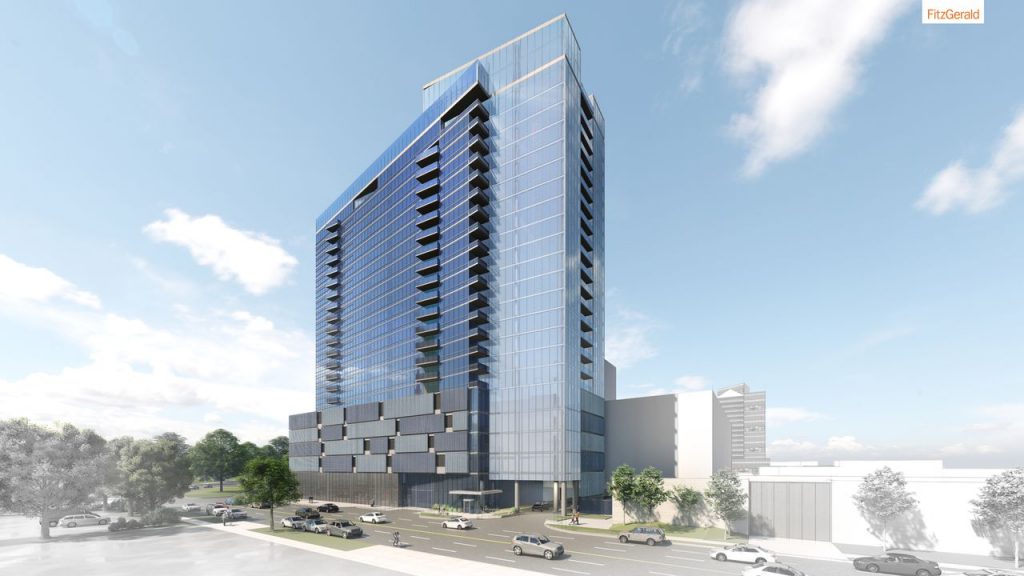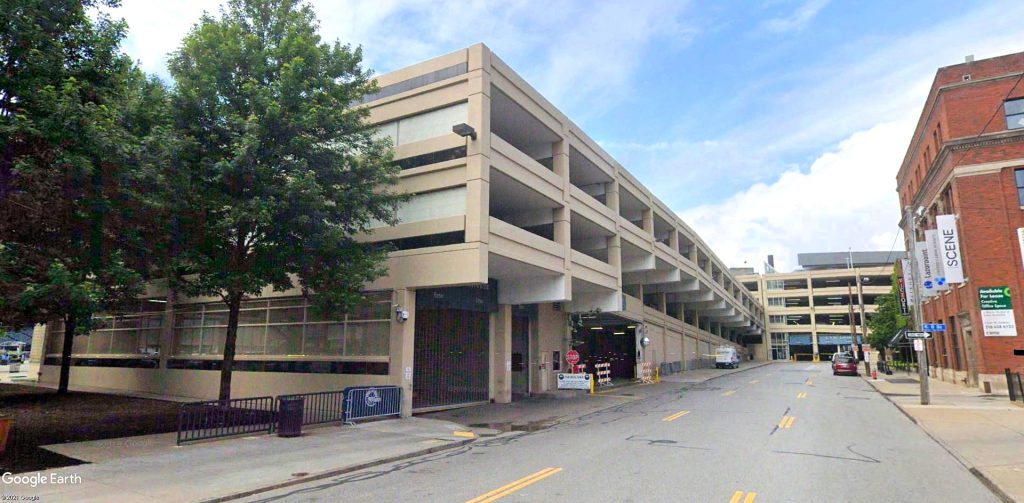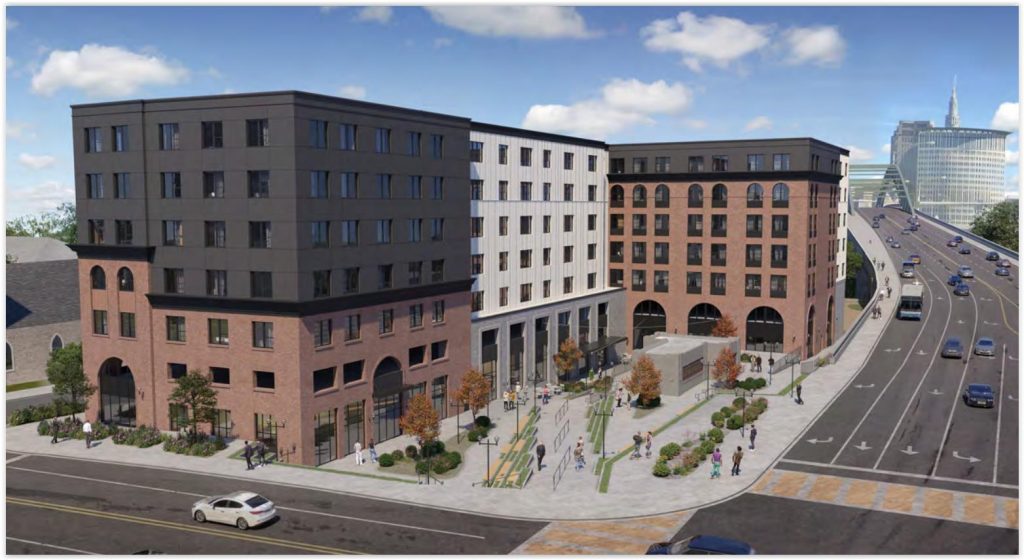Developers of a proposed mixed-use real estate project at West 25th Street and Detroit Avenue are taking actions that show they are increasingly likely to preserve the three existing historic buildings on the site. But it isn’t yet certain how the buildings will be repurposed.
The buildings are the former Cuyahoga County Engineers’ laboratory-office building, a maintenance garage, plus an entrance to a station on the long-closed streetcar subway in the lower level of the 1917-built Detroit-Superior Veterans Memorial Bridge.
The city nominated the buildings for inclusion on the National Register of Historic Places. To be registered would require a recommendation by the Cleveland Landmarks Commission. That recommendation was given at today’s commission meeting.
The nomination form was filled out by Cleveland-based LDA Architects Inc. which reportedly was hired by Bridgeworks LLC, a joint venture led by developers Michael Panzica and Graham Veysey. Today’s Landmarks Commission’s recommendation will be forwarded to Ohio’s State Historic Preservation Office (SHPO) to list the buildings on the national register.
“The nomination is based on the broad patterns of our history and of Cleveland’s transportation history,” said commission Secretary Donald Petit. “The (Detroit-Superior) bridge is already on the national historic register.”
During the Landmarks meeting, commission Chair Julie Trott questioned why the lab-office building was included in the nomination.
“I do think it’s got an association with the bridge,” Petit replied, adding that the lab building is also more than 50 years old, thereby making it eligible for federal and/or state historic tax credits.
Getting listed on the national register will also aid Bridgeworks’ efforts to secure historic tax credits for the renovation of the historic structures. The credits would be added to the still-emerging capital stack for the development of the overall 2-acre county property, according to two sources familiar with the project but were not authorized to speak on the record.
Also still emerging is the programming for the development site. An apartment building up to 10 stories tall is reportedly being considered that could also include other uses in that building, a separate new building or in the historic structures. The ancillary uses could offer a mix of a boutique hotel, ground-floor retail/restaurants or possibly other commercial space.
According to the zoning code, the height district for the development is a “Five” meaning that buildings up to 250 feet tall can be built here. United Community Developers is taking advantage of that change to pursue construction of a 27-story apartment tower called The Viaduct?across Superior Viaduct from the Bridgeworks site. The city recently changed the height district here from a “Three” which allowed buildings up to 115 feet high.
With Bridgeworks’ programming still undetermined, the site plan is also in a state of flux. As recently as last month, the developers considered demolishing the three former county buildings and starting fresh with a blank slate.
“They’re still working through their proposed programming and design,” Petit said.
Keeping and renovating the historic buildings have their own challenges. Constructing new buildings that physically touch the historic structures could raise the ire of the SHPO and put historic tax credits in jeopardy. So the development team’s challenge may be to conjure a plan that integrates new structures with the existing buildings without physical contact, the sources said.
Neither Panzica or Veysey would comment on the Landmarks Commission’s action or how they plan to repurpose the three former county engineers’ buildings.
Bridgeworks won a 2019 bid from the county to acquire the county’s property. NEOtrans broke the story about the property becoming available and, later, that a partnership led by Panzica won the bid. Title to the property has yet to transfer to Bridgeworks LLC or an affiliate however the former Superior Viaduct street right of way through the site was vacated last year,?public records show.
 |
| This is the county engineers’ maintenance garage. Above the center of the Art Moderne-designed building is an engraving that reads “1941 Cuyahoga County” (Google). |
In total, the three buildings offer 21,616 square feet of usable space, county records show. The three-story, 1964-built county engineers’ materials testing laboratory is the tallest building. Petit said the maintenance garage was designed in the Art Moderne style and built in 1941. And the subway station entrance building originally dates to 1917 but was updated in 1939. It opens up another world of potential opportunities.
“The subway connection will remain,” Petit said.
The streetcar subway was closed to rail traffic in January 1954 when the Madison Avenue line out to Riverside Drive in Lakewood via Bridge Avenue was the last streetcar route in Greater Cleveland to be converted to bus operation. That left the four-track subway deck (with enough room for two more tracks) without a public purpose — other than structurally supporting the overhead roadway deck.
After the Detroit-Superior bridge was rebuilt for the city’s bicentennial in 1996, the subway deck was re-opened at least once a year for public, self-guided walking tours, historical displays and interactive art exhibitions. To the south of the bridge, properties and funding are being amassed for the $100 million Irishtown Bend Park and hill stabilization effort.
The Bridgeworks site is between two development hotbeds. One is Hingetown where a development built or planned since 2000 occupies nearly every block. The other hotbed is Flats West Bank where high rises, riverfront development and public spaces are under active planning and development.
END






